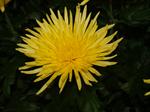 An extract from our ebook "Growing and Knowing Perennials"
An extract from our ebook "Growing and Knowing Perennials"
CHYSANTHEMUM
Family: Asteraceae (syn. Compositae)
Common Name: Crysanths, Mums
Origin: Many from East Asia, but also North Africa. the Mediterranean, Britain and Europe.
Appearance: Annuals and perennials with daisy flowers ranging from small to large and in many colours. The perennial species are generally hardy with deeply lobed foliage and double or single flowers.
Culture: Grow in full sun, although the florist varieties will tolerate a little shade, in well-drained but moist and humus-rich soils. Space them at least 45cm apart, and if they’re in a mixed border, plant them in groups of three for an effective display; they may require staking. Cover the soil with mulch and keep the plants well watered, especially in dry periods. Most varieties are shallow rooted so take care when weeding around the plants.

The plants are heavy feeders, especially in the early leafy stages when they need plenty of nitrogen. As they become established, a more balanced fertiliser with adequate potassium and phosphorus will help buds and flowers to form. Regular liquid feeds are also useful, but only until the buds begin to form.
Pinch out the growing tips when the plants are around 20cm high – this will promote the development of side shoots so that the plants will become bushy with many stems carrying large clusters of flowers. Some growers continue to pinch out the side shoots, to encourage earlier, bigger flowers.
Propagation: Perennials may be divided when dormant, or grown from half-hard summer cuttings.
Health: Pests include aphids, thrips, earwigs, red spider mites, caterpillars and leaf miners. Diseases include leaf spots, powdery mildew, rust and viral diseases. Regular control (e.g. suitable sprays) and non-chemical control methods (such as hand removal of larger pests) will help keep most under control. If you suspect a viral problem, or if the plant is suffering severely from other diseases, destroy the plant to avoid spreading the disease.
Uses: As florist's flowers, massed displays in gardens and parks, edging plants in borders, container plants, bedding plants, and tender species are used as greenhouse plants.
Cultivars/Species: Approximately 40 to over 200 species in this genus depending on the authority, and very many hybrids and cultivars. The most widely grown being:
C. x grandiflorum (and its numerous cultivars)
C. x frutescens - to 45cm tall (or to 1m in a greenhouse) with pale green leaves and white or yellow flowers to 5cm wide.
C. maximum (Shasta Daisy) - to 1m tall with dark green toothed leaves and single white flowers with a yellow centre to 7.5 cm wide. Many named varieties.
C. x morifolium